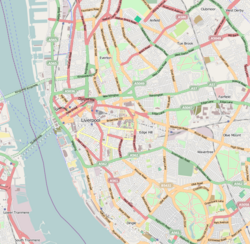
Princes Road Synagogue is a synagogue on Princes Road in the Toxteth district of Liverpool, England. It is the home of the Liverpool Old Hebrew Congregation. It was founded in the late 1860s, designed by William James Audsley and George Ashdown Audsley, and consecrated on 2 September 1874. It is widely regarded as the finest example of the Moorish Revival style of synagogue architecture in the UK, and synagogues emulating its design can be found as far away as Sydney.

The Singers Hill Synagogue, officially the Birmingham Hebrew Congregation, is an Orthodox Jewish congregation and synagogue, located at 26, 26A and 26B Blucher Street, in the Birmingham city centre, in the West Midlands of England, in the United Kingdom. The congregation dates from 1780 and worshiped in the Ashkenazi rite.

Greenbank was an electoral district of Liverpool City Council between 2004 and 2023.

The New West End Synagogue is an Orthodox Jewish congregation and synagogue, located in St. Petersburgh Place, Bayswater, in the City of Westminster, London, England, in the United Kingdom. The congregation has been a member of United Synagogue since 1879.
The Torah Temimah Primary School, located in the former Dollis Hill Synagogue, is a one form entry Voluntary Aided maintained primary school in the London Borough of Brent. It is a strictly Orthodox Jewish single-sex primary school for up to 204 boys aged 3–11. The school includes a Nursery.
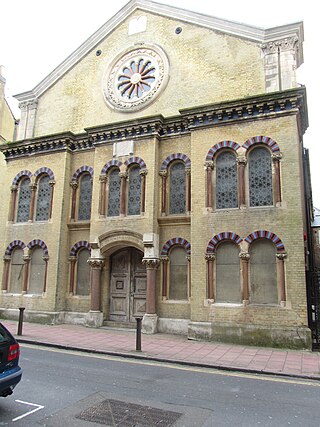
The Middle Street Synagogue is a synagogue in the centre of Brighton, part of the English city of Brighton and Hove. It was the centre for Jewish worship in Brighton and Hove for more than a century. Although it is not in full-time use, the building is still open at certain times, and cultural events frequently take place, as do weddings. It has been listed at Grade II*, reflecting its architectural and historic importance.

The Sunderland Synagogue is a former Orthodox Jewish congregation and synagogue, located on Ryhope Road, in Sunderland, Tyne and Wear, England, in the United Kingdom. The congregation was formed as the Sunderland Hebrew Congregation in 1861 and worshiped in the Ashkenazi rite until the congregation was dissolved in 2006.
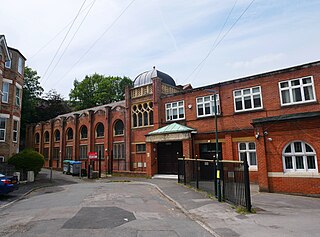
The Bournemouth Community Hebrew Congregation is an Orthodox Jewish congregation and synagogue, located in Wootton Gardens, Lansdowne, Bournemouth, Dorset, England, in the United Kingdom. The congregation was formed in 1905 and worships in the Ashkenazi rite. The rabbi of the congregation is Adrian Jesner.

The Cheltenham Synagogue is a synagogue in Cheltenham and is noted for its Regency architecture. It is an independent congregation located in the town centre on Synagogue Lane, off St James's Square.
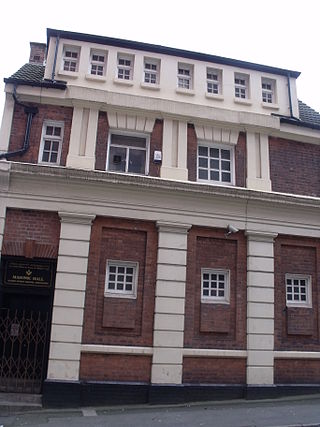
The Severn Street Synagogue is a former Orthodox Jewish congregation and synagogue, located at 60 Severn Street, Birmingham, West Midlands, England, in the United Kingdom. The congregation was founded in 1809 and worshiped in the Ashkenazi rite until the congregation was merged into the Singers Hill Synagogue congregation in 1856.
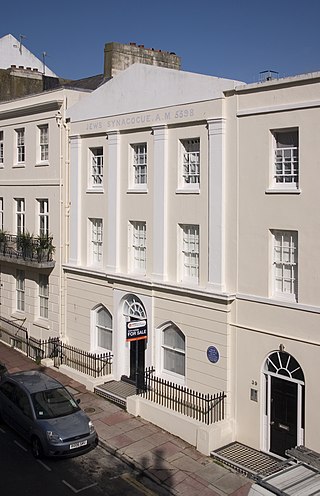
The Brighton Regency Synagogue, also called the Devonshire Place Synagogue, is a former Orthodox Jewish congregation and synagogue, located at 38–39 Devonshire Place, Kemptown, Brighton and Hove, in East Sussex, England, in the United Kingdom. The congregation, established in 1824, worshiped in the Ashkenazi rite.

The Brunswick Terrace Synagogue, also sometimes called the Roof-top synagogue, was a private Orthodox Jewish synagogue that was built on the roof-top of 26 Brunswick Terrace, a terraced-row of houses on the Brunswick Estate in Hove, now a constituent part of the city of Brighton and Hove, in East Sussex, England, in the United Kingdom.

The architecture of Liverpool is rooted in the city's development into a major port of the British Empire. It encompasses a variety of architectural styles of the past 300 years, while next to nothing remains of its medieval structures which would have dated back as far as the 13th century. Erected 1716–18, Bluecoat Chambers is supposed to be the oldest surviving building in central Liverpool.
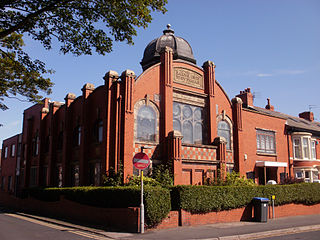
The Blackpool United Hebrew Congregation is a former Orthodox Jewish congregation and synagogue, located on Leamington Road, Blackpool, Lancashire, England, in the United Kingdom. The congregation worshiped in the Ashkenazi rite. The former synagogue building was listed as a Grade II building in 1998.
Liverpool is a city and port in Merseyside, England, which contains many listed buildings. A listed building is a structure designated by English Heritage of being of architectural and/or of historical importance and, as such, is included in the National Heritage List for England. There are three grades of listing, according to the degree of importance of the structure. Grade I includes those buildings that are of "exceptional interest, sometimes considered to be internationally important"; the buildings in Grade II* are "particularly important buildings of more than special interest"; and those in Grade II are "nationally important and of special interest". Very few buildings are included in Grade I — only 2.5% of the total. Grade II* buildings represent 5.5% of the total, while the great majority, 92%, are included in Grade II.

Shakespeare Street Wesleyan Reform Chapel is a former Wesleyan Reform church on Shakespeare Street in Nottingham, England, in the United Kingdom. The building was converted in 1953 to a synagogue and is now a university hall. Whilst in use as a synagogue, in 1972 the building was listed as a Grade II building.
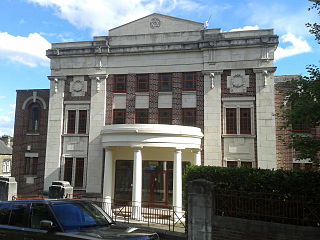
The Wilson Road Synagogue is a former Orthodox Jewish congregation and synagogue, located at 11 Wilson Road, Ecclesall, Sheffield, England, in the United Kingdom. The congregation was formed in 1914 and worshiped in the Ashkenazi rite until the congregation was dissolved in 1997.

The Leazes Park Synagogue is a former Orthodox Jewish congregation and synagogue, located at 12 Leazes Park Road, Newcastle upon Tyne, England, in the United Kingdom. The congregation was formed in 1880 and worshiped in the Ashkenazi rite until the congregation was dissolved in 1978.
The Great Park Synagogue is an Orthodox synagogue situated in Houghton, Johannesburg. The present building was consecrated in 2000, after the congregation vacated their long-time home, the Great Synagogue on Wolmarans Street, Hillbrow in 1994, after eighty years. The Wolmarans Street synagogue came to be known as the city's mother synagogue and "the crown jewel of Orthodox Judaism in South Africa." All large-scale Jewish events in Johannesburg were held in the building, and throughout its existence it was the seat of the country's chief rabbi. Northward migration by congregation members led to the synagogue closing its doors in 1994. The relocated synagogue was built on the model of the Great Synagogue, whose own architecture in turn was inspired by the Hagia Sophia. Great Park Synagogue was also the original name of the synagogue on Wolmarans Street before it became the Great Synagogue.

